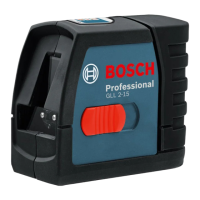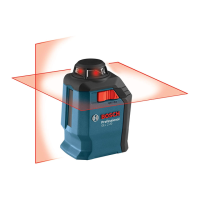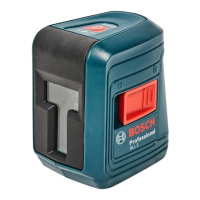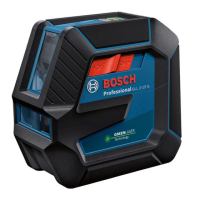English | 15
Bosch Power Tools 1 609 92A 27R | (4.7.16)
– Without turning the measuring tool, position it close to
wall B. Switch the measuring tool on and allow it to level in.
– Align the height of the measuring tool (using a tripod or by
underlaying, if required) in such a manner that the cross
point of the laser lines is projected against the previously
marked point II on the wall B.
– Without changing the height, turn around the measuring
tool by 180°. Direct it against the wall A in such a manner
that the vertical laser line runs through the already marked
point I. Allow the measuring tool to level in and mark the
cross point of the laser lines on the wall A (point III).
–The difference d of both marked points I and III on wall A
indicates the actual height deviation of the measuring tool.
The maximum permitted deviation d
max
is calculated as fol-
lows:
d
max
= double distance of the walls x 0.3 mm/m
Example: With a 5 metre distance between the walls, the max-
imum deviation must not exceed
d
max
=2x5mx0.3mm/m=3mm. Thus, the marks must not
be more than 3 mm apart.
Checking the Levelling Accuracy of the Horizontal Line
For the check, a free surface of approx. 5 x 5 metres is re-
quired.
– Set up the measuring tool on a firm, level surface between
both walls A and B. Allow the measuring tool to level in
while in horizontal operation.
– At a distance of 2.5 metres from the measuring tool, mark
the centre of the laser line (point I on wall A and point II on
wall B) on both walls.
– Set up the measuring tool 5 metres away turned by 180°
and allow it to level in.
– Align the height of the measuring tool (using a tripod or by
underlaying, if required) in such a manner that the centre
of the laser line is projected exactly against the previously
marked point II on wall B.
– Mark the centre of the laser line as point III (vertically
above or below point I) on the wall A.
–The difference d of both marked points I and III on wall A
indicates the actual deviation of the measuring tool from
the level plane.
The maximum permitted deviation d
max
is calculated as fol-
lows:
d
max
= double distance of the walls x 0.3 mm/m
Example: With a 5 metre distance between the walls, the max-
imum deviation must not exceed
d
max
= 2 x 5 m x 0.3 mm/m = 3 mm. Thus, the marks must not
be more than 3 mm apart.
A
B
d
180˚
A
B
2,5 m
A
B
d
OBJ_BUCH-817-007.book Page 15 Monday, July 4, 2016 6:35 PM

